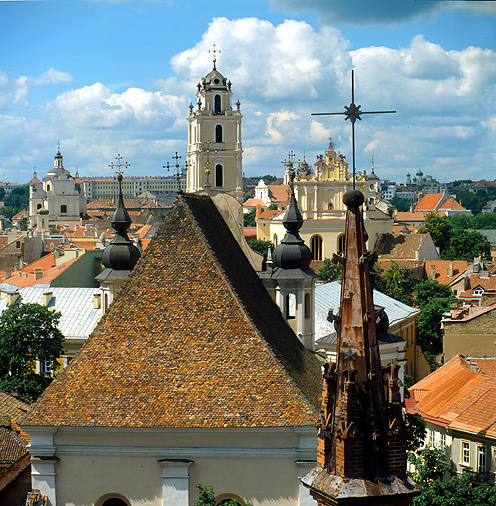History

The Archdiocese of Vilnius is fundamentally related to the development of Lithuania’s statehood, and with the nation joining other Christian nations of Europe. In 1253, because of the effort of King Mindaugas, a diocese was established which was directly subordinate to Rome, and was given the name Lietuva. During the coronation of Mindaugas, the first cathedral was built in Vilnius. Unfortunately, Christianity’s beginning was short-lived and the heritage of the Diocese of Lithuania was not directly taken over.
As the Grand Duke Jogaila was christening Lithuania, he established the first parishes, and built a brick cathedral in Vilnius in 1387. In 1388, the Diocese of Vilnius was created, and the Chapter of Vilnius Cathedral and Lithuania’s Grand Duchy joined Christian Europe.
Vilnius was becoming well-known in the 15th C. as a Christian capital and was adorned with sacredness when St. Casimir (1458-1483) lived and was buried there. In 1579, during the period of Church Reform, the Jesuits in Vilnius established the first Lithuanian University, which was one of the first in the region.
In 1795, after the third Division Of Two Nation Republics, the Diocese of Vilnius was given to Russia. The Diocese was eliminated by secular authorities, and later, in 1798, was assigned to the metropolis of Mogiliovas. Ordinaries of bishops occasionally ruled over the diocese during the 19th C., but mostly temporary administrators or vicars from the Chapter.
When Lithuania declared independence in 1918 and governments were changing, in a climate of national opposition, the Diocese of Vilnius experienced a great deal of tension. During an especially turbulent time between 1918–1925, Bishop Jurgis Matulaitis was in charge. (In 1987 he was declared Blessed). With the continuing conflict over Vilnius, Warsaw signed Concordat with the Vatican in 1925. The outcome of the agreement was that lands that were part of the Diocese of Vilnius, which entered into the territory of Poland, became part of the Vilnius Archdiocese. The remaining parishes of the Diocese were formed into the Kaišiadorių Diocese.
In1939, when Vilnius and the surrounding regions of Vilnius were returned to the Republic of Lithuania, the borders of the country and the boundaries of the Archdiocese did not coincide anymore. Administration of the Church territories was complicated because of the Soviet, Nazi, and second Soviet occupations. It was difficult to have clearly defined territory of Lithuania, Poland and Belarus. For half a century, the Archdiocese was ruled by pastoral administrators or temporary managers. Only in 1989 did the rightful shepherd return to Vilnius after years of exile-Archbishop Julijonas Steponavičius.
The current era of the Archdiocese of Vilnius began in 1991 on December 24th when Pope John Paul the II reorganized church territories after Lithuania had declared its independence. The Vilnius Metropolitan was established and was assigned the Diocese of Kaišiadorys and Panevėžys. The first metropolitan in Vilnius became Archbishop Audrys Juozas Bačkis, who on February 21st, 2001 was appointed Cardinal by the Holy Father.
After many decades of religious persecution and forced atheism, the Archdiocese had to start from the beginning to establish Church structures, develop pastoral care, catechism, as well as charitable work. St. Joseph’s Priest’s Seminary was re-established in 1993 and in 1998, moved to a new location. The charitable food shelter Betanija has been operating since 1992. Caritas runs many social programs. The Family Center, the Lithuanian and Polish Catechist Centers, and the Youth Center all provide help from the clergy, monks, and laypeople who initiate and coordinate Catholic projects.
At centers of higher education in Vilnius, academic pastoral care is constantly developing. Trinapolis, the former summer Bishop’s Residence, has a separate retreat house. The Lithuanian Catholic Education Academy’s Central Office work is very important for Catholic Education and academic development. Religious teachers are educated at Lietuvos Edukologijos Universitetas in the Department of Theology.
For centuries, people of many nations and cultures lived within the Diocese. Old Vilnius was becoming famous for religious tolerance and in the more modern era, it became an important center for ecumenism. The historical proximity of Orthodox neighbors was especially significant for the Grand Duchy of Lithuania, which covered the peripheries of the Christian East and West. Catholics, as well as Orthodox, believe in the miraculous painting of the Blessed Virgin Mary of the Gates of Dawn. Since the 17th C., worshippers have been flooding to this location, one of the most significant pilgrimage sites in the Archdiocese. In 1997, the Shrine of Aušros Vartų (the Gates of Dawn) was visited by the Patriarch of Moscow- Aleksijus II. His meeting and prayers with the Archbishop of Vilnius, the Archbishop Audrius Juozas Bačkis was significant for dialogue between the Eastern and Western Churches.
The greatest and most significant event for the current Archdiocese happened in 1993, when Pope John Paul II was on an apostolic journey to Lithuania, visited Vilnius, and prayed at the Archcathedral and at the Gates of Dawn. He provided significant direction for renewal in the Church and society after decades of totalitarianism.
On April 5th, 2013, Pope Francis appointed the Bishop of Vilnius Gintaras Grušas to Archbishop Metropolitan. His ordination at the Archcathedral on April 23rd took place on the feast of St. George, the patron saint of the Archdiocese.